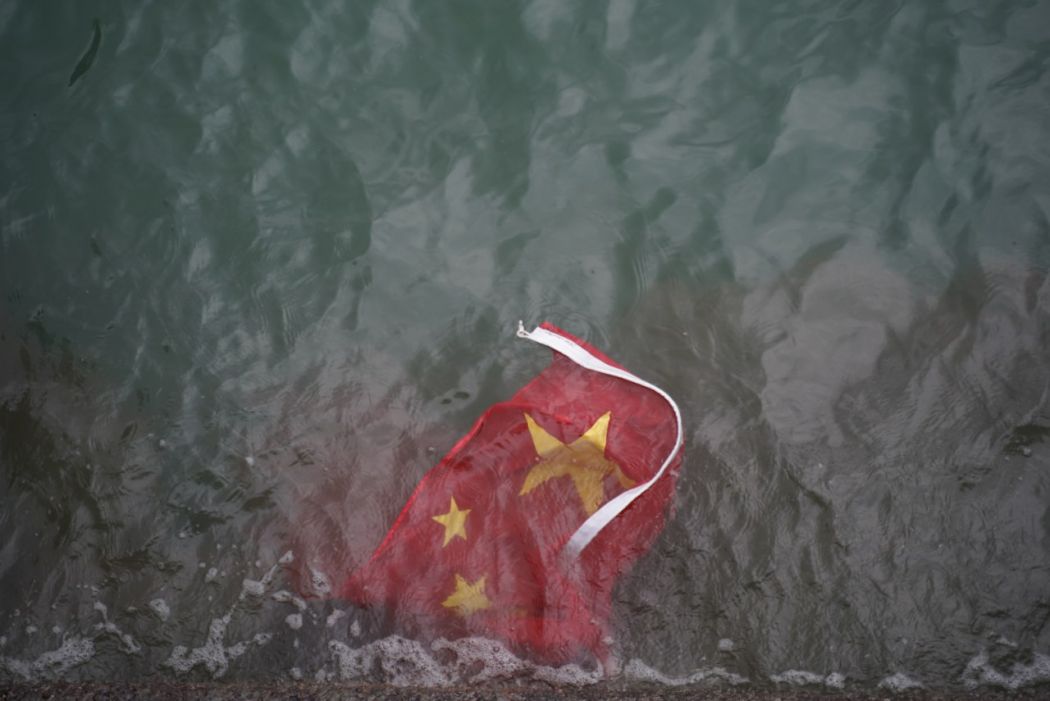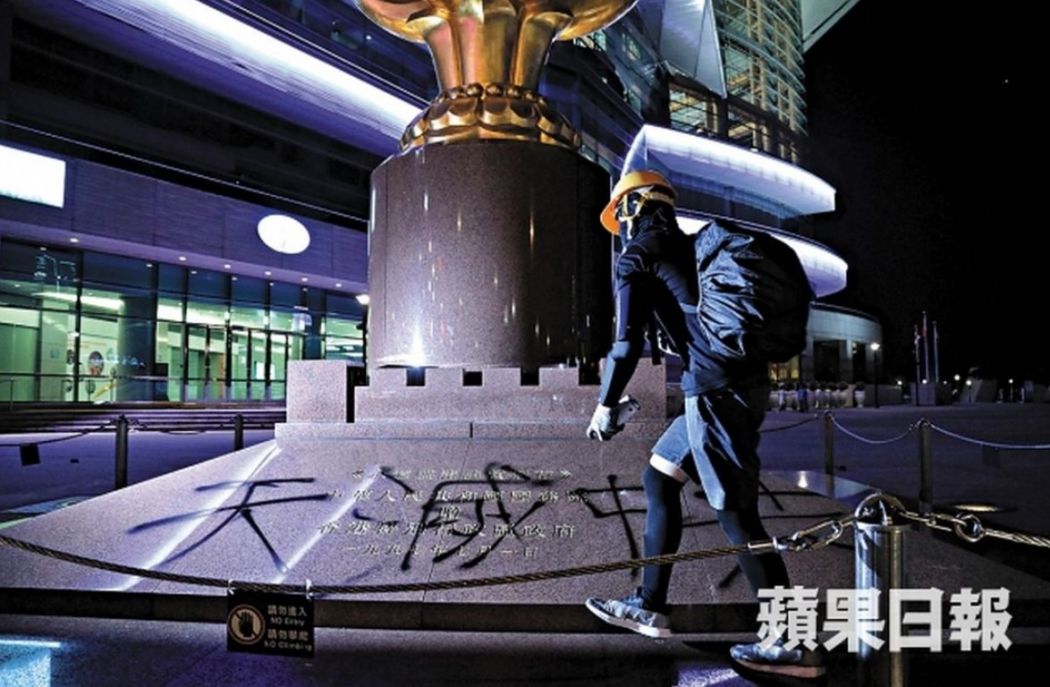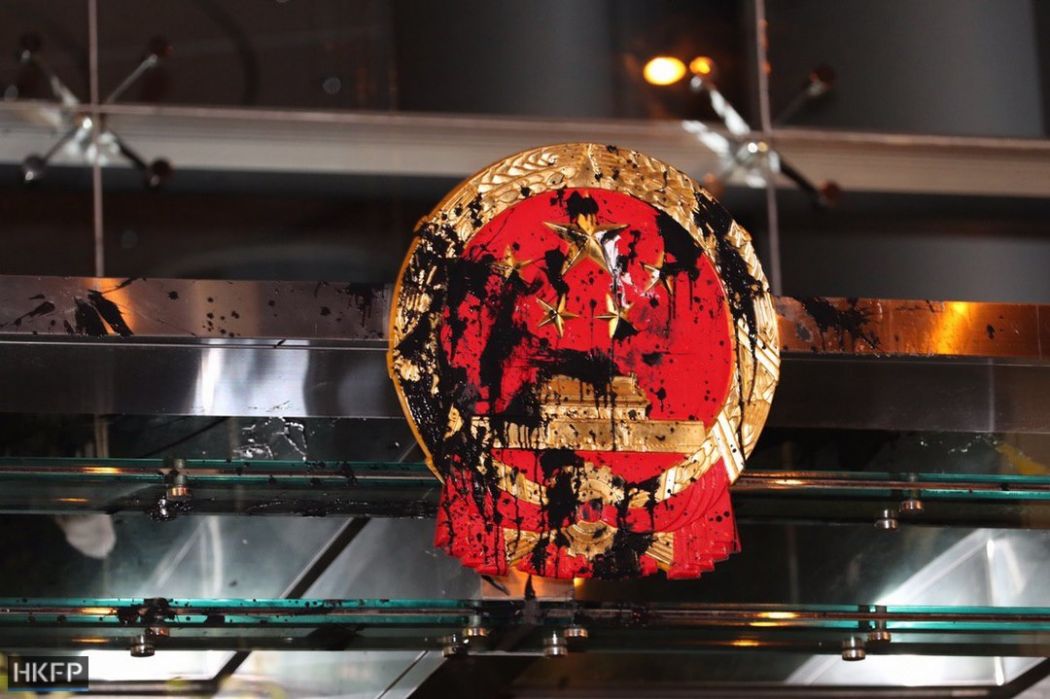The Chinese national flag was floating in the waters of Victoria Harbour twice last weekend, after protesters rallying in Tsim Sha Tsui pulled it down from its pole and flipped it into the ocean.

Also last Saturday night, a similar disrespect was shown to the Golden Bauhinia – a gaudy, artichoke-like thing painted in fool’s gold sitting in front of the Convention and Exhibition Centre, representing Hong Kong’s return to Chinese sovereignty and visited only by selfie-hungry tourists. Black paint was sprayed on its pedestal to form a slogan saying that “Heaven will put an end to the Communist Party.”

Protesters were keen on attacking these charged symbols. Like they had done on July 21, when they smeared the façade of the Liaison Office, Beijing’s highest representative in Hong Kong, with slogans. One read “Fuck Cheena”, using a distortion of the country’s name that recalls an anti-Chinese insult from the times of the Japanese invasion.

Another, a touch pedantic, only said “One Country Two Systems” as a reminder to the Liaison Office of what the deal was supposed to be. More provocatively yet, the red and gold emblem of the People’s Republic of China was doused with quite a lot of dripping black paint. Now, to prevent any defacing, the whole Liaison Office sits behind protective water barricades, and the offending emblem has been swiftly replaced with a new, spotless one, encased in Plexiglas for added security.

Before this recent escalation in bold provocation, other symbols had been targeted: most notably, the Legislative Council, which was forcibly entered on July 1, when protesters managed to smash a couple of glass panels and lift a back door to enter the Chamber. Same pattern: political slogans (and a few insults) sprayed on the walls, defacing of the symbols of power, and selective vandalism (drinks got paid for at the automatic machines, the books and files in the library left untouched). This is the very LegCo from which a few politicians that had emerged from the protest movement of 2014 were kicked out with spurious political motivations, and the protesters forced themselves back in.
The official reaction to all this is chilling. Last month, the sight of broken glass hurt some feelings: Carrie Lam, so rarely seen in public, briefly interrupted her retreat to express pain at the sight of those shards. She didn’t mention any sorrow at the sight of young people being the victims of excessive police force. Much worse, she said nothing about those who had lost all hope and committed Hong Kong’s first (and let’s hope last) teenagers’ political suicides. It took a couple of days more for a member of the government to express sorrow at these tragic and avoidable deaths.

If shattered glass has made appointed politicians sad, the disfiguring and the drowning of national emblems has brought about a wave of horrified statements that in a less volatile moment would be really quite interesting. The former Chief Executive, Leung Chung-Ying, the most unpopular leader of Hong Kong before Carrie Lam took the top job, has been so offended by the floating flag that he has offered monetary compensation – one million dollars! – to whomever can bring the responsible person to justice (the paint on the golden artichoke’s pedestal hasn’t elicited any promise of pecuniary reward, at least for now). The blackened national emblem, on the other hand, prompted Xinhua, China’s news agency, to write: “When the majestic national emblem of the People’s republic of China was defaced with black paint, it caused unbearable pain and anger”.
Rioters Sunday spray-painted & threw stones at the statue on Golden Bauhinia Square, a gift from central govt to mark HK’s return and a symbol of #HK‘s autonomy. The vandalization is a direct attack on the rule of law. The patience of 1.4b Chinese people must not be tested! #香港 pic.twitter.com/PbzUBwWHRJ
— Global Times (@globaltimesnews) August 4, 2019
Meanwhile, hundreds of commuters, protesters among them, were victims of a brutal attack by organised criminal gangs, who started beating the hell out of anything that moved, at Yuen Long’s MTR station. They entered the trains. They left and came back for a second round. In total impunity, with no police to be seen. No tear gas to disperse anyone. No acknowledgement afterwards that those scenes had shocked Hong Kong to its very core, and yes, caused unbearable pain and anger. Those who were scarred were not inanimate objects, but Hong Kong people. Peacefully returning home after a day at work or joining protests.

Nationalism is a strange religion. It worships flags and emblems, and shivers with pain and rage if those are touched, but is quite cold to people. The symbols of the People’s Republic are untouchable – as doing so, according to the authorities, is an attack on sovereignty.
But what about the people of the People’s Republic, even the ones in the Special Administrative Region? Those, unlike its emblems, are being treated as if they were expendable. Their suicides bring no tears to eyes that get puffy over a flag. A terror attack against them in an underground station elicits no offers of reward for those who can find the culprits. With official values this skewed, how is peace going to come back to Hong Kong?
